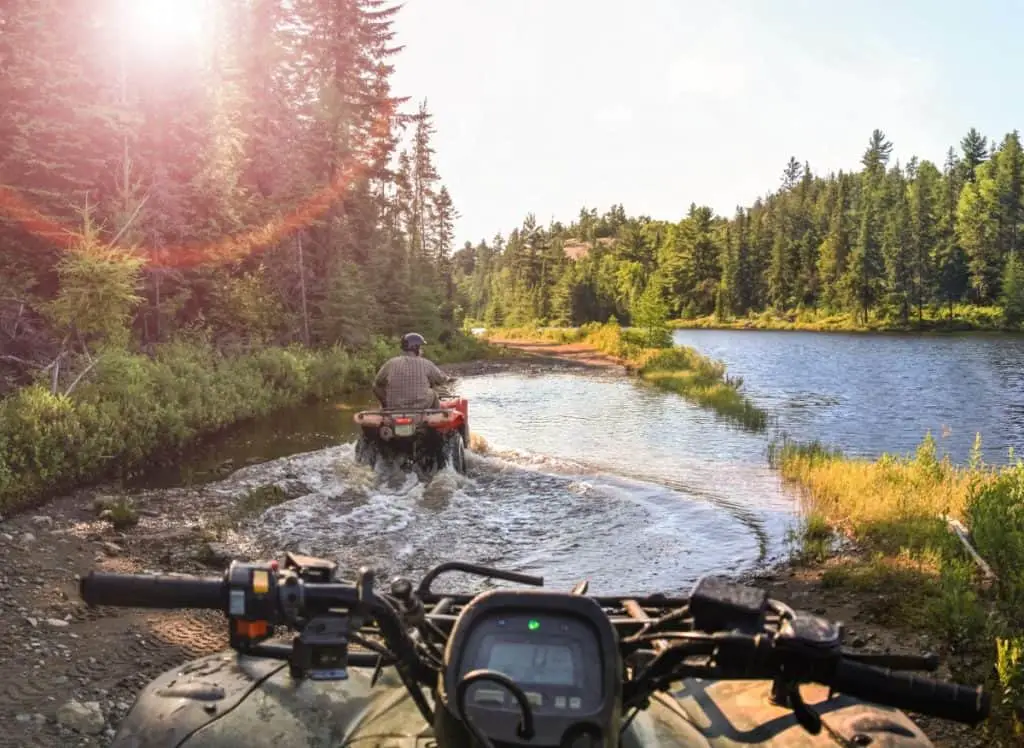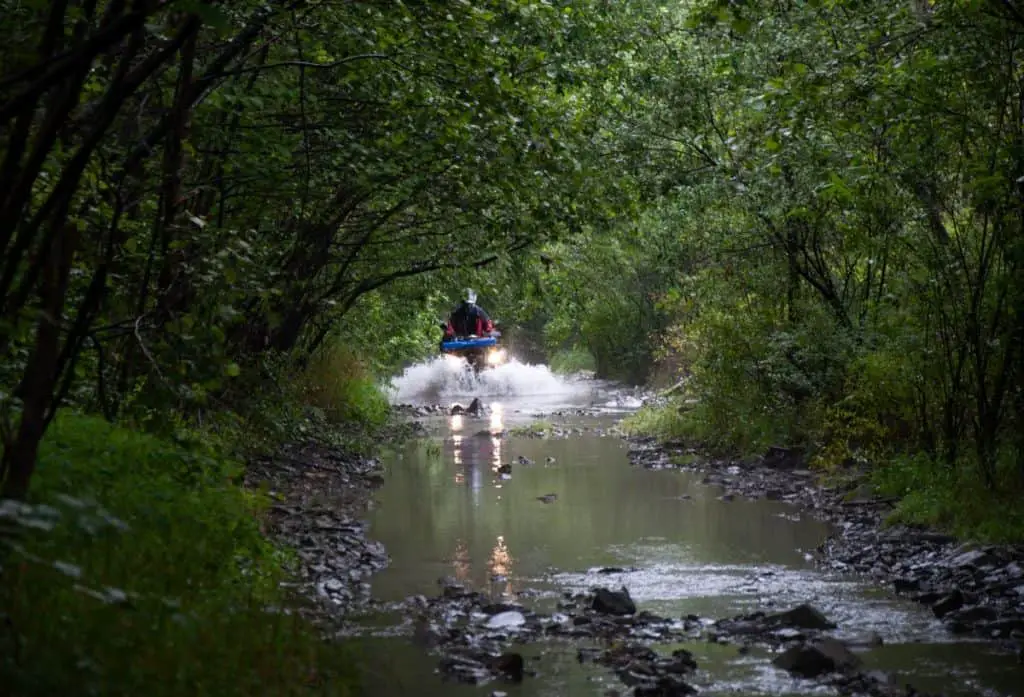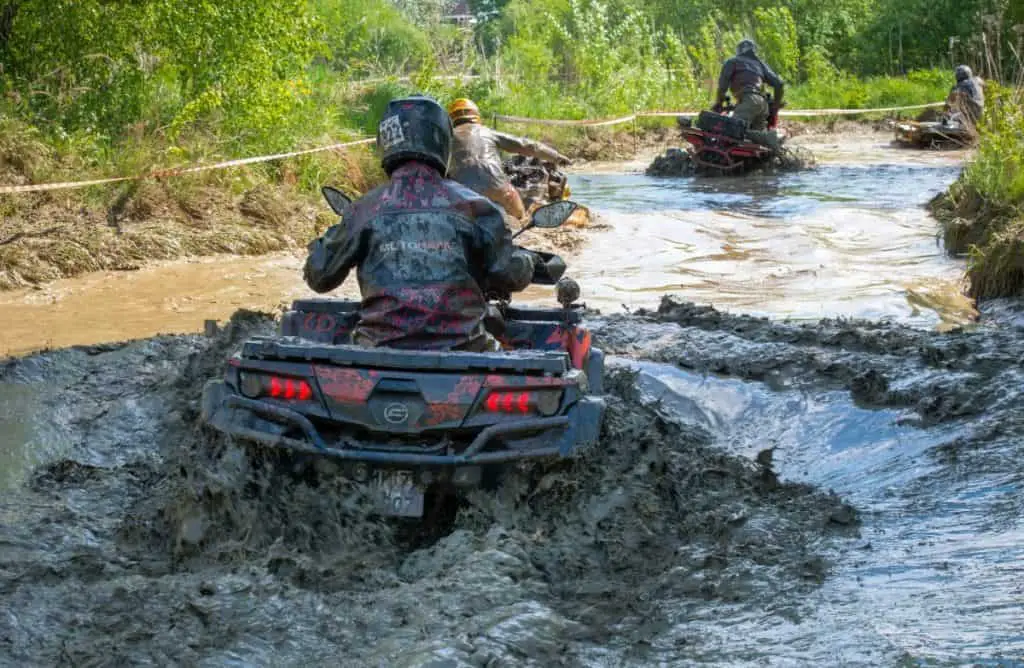I’ve been using my ATV around some wet and muddy areas, and I was curious how deep I can ride my ATV in water. I looked at the technical specifications for popular ATVs and here’s what I found.
On average, ATVs can go 14 inches (35 cm) deep in water. If you attempt to go in water deeper than that you can cause water to get into the engine which can cause part failures. Fast flowing water should be avoided, and you should avoid going over 4 miles per hour (6.5 km per hour) in water.
Below, I will examine different models of ATVs and compare how deep they can go in the water. As well as, what you need to be aware of when riding your ATV in water, what to do if you get water in the engine, and how much it costs to snorkel and ATV.

Can All ATVs Go in Water?
I’ve seen A bunch of different ATVs, quads, and four-by-fours and wondered whether there are some that are specially designed to go in water, as well as, whether most ATVs you buy can go in water.
As a general rule, all ATVs can go in water up to 14 inches (35 cm) deep. The main consideration is that water doesn’t get high enough to enter the air intake valves. When water is above this depth, it’s likely water will cause your ATV to turn off.
Also, the deeper the water the more difficult it is to winch out if it does get stuck.
Snorkels for riding in deeper water
For driving in deeper water, there are some steps you can take to ensure your ATV can handle it. These are to install a snorkel on the air intake valves.
MotoSport.com recommends snorkeling your airbox, clutch belt housing intake, and clutch belt housing exhaust.
Various people who have ridden ATVs in water have observed that it’s perfectly fine to go in water up to about halfway up your ATV. However, doing that does put you at greater risk of water getting into the engine.
How deep can you go with a snorkel on your ATV?
An ATV can go about 3 ft (1 meter) deep with a snorkel attachment. A custom snorkel can be made that will extend far higher into the air. However, it can get in the way especially when riding through forested areas where there are low-hanging tree branches.
Provided water doesn’t get into the hole at the top of the snorkel technically you can go a lot deeper.
However, to be on the safe side it’s best to only push the limits if you absolutely have to. The reason is that if water does get into the snorkel it will get into the engine and the engine can shut off.
What to do if you get stuck
Then you’ll need to winch it out. A winch may or may not come with your ATV. But, you can get them for around $300 online. They will allow you to rescue yourself if you get stuck. You attach the winch to a nearby tree or fixed object and then press the button on the winch to pull your ATV out.

Tips for riding through water from riding experts
I find riding ATVs so much fun that it’s easy to become reckless and perform some questionable maneuvers. However, there are some best practices when riding an ATV through water that I’ll cover briefly here.
1. Enter the water slowly
When riding through water, you do not want to be going fast, and you want to enter the water even slower. The top speed you should go on an ATV through water is 4 miles per hour (6.5 km per hour).
2. Pump the brakes upon exiting the water
Interestingly, water that gets on the brakes can make the brakes more slippery. As a result, the first time you pump the brakes it can take longer to brake.
Therefore, it’s a good idea to pump the brakes a few times once you exit the water. That way you can double-check the brakes are working as they should.
3. Be extra cautious around other vehicles
Your ability to brake, accelerate and turn isn’t as good when you’re riding through water. Therefore, you should take extra care of other vehicles. Apply the same rules you would to driving in snow/ice/and water.

What do you do if you get water in my ATV engine?
Although I plan on never getting water in my ATV engine, I wanted to know ahead of time what I should do if I get water in my ATV engine. Based on the advice of ATV mechanics here’s what you should do.
First, don’t try to start the engine, it can cause serious damage. The steps involved are:
1. Remove the air filter and set it aside to dry
2. Remove spark plugs if you have them
3. Lift the ATV straight up and down to drain the water
4. Look for water coming out of the airbox
Once all the water has come out, start it up again. Each of these steps is a bit complicated to explain. Here’s a quick video that shows the process for a standard dirt bike. The same rules apply to ATVs.
The parts mentioned in the video can be in different locations to those shown. So, it’s best to familiarize yourself with the user manual so you know where each of the parts are. And you need to do it out of the road.
How much does it cost to snorkel an ATV?
I thought about snorkeling my ATV but came to the conclusion that I don’t ride it in water enough to make it worth it for me. While I was researching snorkeling my ATV I got a good idea of how much it costs. Here’s what I found.
A good price to have an ATV snorkeled is $300 to $375. It’s definitely possible to snorkel it yourself, and an average snorkel on its own costs $200. Therefore, you save $100 to $175 snorkeling it yourself. It is complicated and time-consuming for an average person to snorkel their own ATV.
However, if you have a mechanic background, or are good with tools you’re more suited to installing a snorkel on your own ATV.
Otherwise, some people who have done it themselves are of the opinion it’s not worth the hassle to do it yourself. And it’s better to have someone install it for you.
